Phanerozoic Burial and Erosion History of the Southern Canadian Shield from Apatite (U-Th)/He Thermochronology
Abstract
1. Introduction
2. Geologic Background
2.1. Geologic Setting
2.2. Previous Thermochronology of the Superior Craton and Grenville Province
3. Materials and Methods
3.1. (U-Th)/He Background and Samples
3.2. (U-Th)/He Analytical Methods
4. Results
5. Discussion
5.1. Geologic Context, Data Patterns, and Model Framework
5.2. Testing Phanerozoic Burial and Erosion across the Southern Canadian Shield
5.3. Thermal History Modeling Results
5.4. Phanerozoic Burial and Erosion Model for the Southern Canadian Shield
6. Conclusions
Supplementary Materials
Author Contributions
Funding
Data Availability Statement
Acknowledgments
Conflicts of Interest
References
- Sloss, L.L. Sequences in the Cratonic Interior of North America. Geol. Soc. Am. Bull. 1963, 74, 93–114. [Google Scholar] [CrossRef]
- Sloss, L.L. Tectonic Evolution of the Craton in Phanerozoic Time. In Sedimentary Cover: North American Craton; Sloss, L.L., Ed.; Geological Society of America: Boulder, CO, USA, 1988; Volume D-2, pp. 25–51. [Google Scholar]
- Mitrovica, J.X.; Beaumont, C.; Jarvis, G.T. Tilting of Continental Interiors by the Dynamical Effects of Subduction. Tectonics 1989, 8, 1079–1094. [Google Scholar] [CrossRef]
- Gurnis, M. Phanerozoic Marine Inundation of Continents Driven by Dynamic Topography above Subducting Slabs. Nature 1993, 364, 589–593. [Google Scholar] [CrossRef]
- Burgess, P.M.; Gurnis, M.; Moresi, L. Formation of Sequences in the Cratonic Interior of North America by Interaction between Mantle, Eustatic, and Stratigraphic Processes. Geol. Soc. Am. Bull. 1997, 109, 1515–1535. [Google Scholar] [CrossRef]
- Liu, L.; Spasojevic, S.; Gurnis, M. Reconstructing Farallon Plate Subduction Beneath North America Back to the Late Cretaceous. Science 2008, 322, 934–938. [Google Scholar] [CrossRef] [PubMed]
- Flowers, R.M.; Ault, A.K.; Kelley, S.A.; Zhang, N.; Zhong, S. Epeirogeny or Eustasy? Paleozoic–Mesozoic Vertical Motion of the North American Continental Interior from Thermochronometry and Implications for Mantle Dynamics. Earth Planet. Sci. Lett. 2012, 317–318, 436–445. [Google Scholar] [CrossRef]
- Zhang, N.; Zhong, S.; Flowers, R.M. Predicting and Testing Continental Vertical Motion Histories since the Paleozoic. Earth Planet. Sci. Lett. 2012, 317–318, 426–435. [Google Scholar] [CrossRef]
- Tasistro-Hart, A.R.; Macdonald, F.A. Phanerozoic Flooding of North America and the Great Unconformity. Proc. Natl. Acad. Sci. USA 2023, 120, e2309084120. [Google Scholar] [CrossRef]
- Crowley, K.D.; Ahern, J.L.; Naeser, C.W. Origin and Epeirogenic History of the Williston Basin: Evidence from Fission-Track Analysis of Apatite. Geology 1985, 13, 620–623. [Google Scholar] [CrossRef]
- Crowley, K.D.; Kuhlman, S.L. Apatite Thermochronometry of Western Canadian Shield: Implications for Origin of the Williston Basin. Geophys. Res. Lett. 1988, 15, 221–224. [Google Scholar] [CrossRef]
- Crowley, K.D. Thermal History of Michigan Basin and Southern Canadian Shield from Apatite Fission Track Analysis. J. Geophys. Res. 1991, 96, 697–711. [Google Scholar] [CrossRef]
- Kohn, B.P.; Gleadow, A.J.W.; Brown, R.W.; Gallagher, K.; Lorencak, M.; Noble, W.P. Visualizing Thermotectonic and Denudation Histories Using Apatite Fission Track Thermochronology. Rev. Mineral. Geochem. 2005, 58, 527–565. [Google Scholar] [CrossRef]
- Feinstein, S.; Kohn, B.; Osadetz, K.; Everitt, R.; O’Sullivan, P. Variable Phanerozoic Thermal History in the Southern Canadian Shield: Evidence from an Apatite Fission Track Profile at the Underground Research Laboratory (URL), Manitoba. Tectonophysics 2009, 475, 190–199. [Google Scholar] [CrossRef]
- Pinet, N. Far-Field Effects of Appalachian Orogenesis: A View from the Craton. Geology 2016, 44, 83–86. [Google Scholar] [CrossRef]
- Kohn, B.; Gleadow, A. Application of Low-Temperature Thermochronology to Craton Evolution. In Fission-Track Thermochronology and Its Application to Geology; Malusà, M.G., Fitzgerald, P.G., Eds.; Springer Textbooks in Earth Sciences, Geography and Environment; Springer International Publishing: Cham, Switzerland, 2019; pp. 373–393. ISBN 978-3-319-89419-5. [Google Scholar]
- Flowers, R.M.; Mahan, K.H.; Bowring, S.A.; Williams, M.L.; Pringle, M.S.; Hodges, K.V. Multistage Exhumation and Juxtaposition of Lower Continental Crust in the Western Canadian Shield: Linking High-Resolution U-Pb and 40Ar/39Ar Thermochronometry with Pressure-Temperature-Deformation Paths: Multistage Exhumation of Lower Crust. Tectonics 2006, 25, TC4003. [Google Scholar] [CrossRef]
- Flowers, R.M. Exploiting Radiation Damage Control on Apatite (U–Th)/He Dates in Cratonic Regions. Earth Planet. Sci. Lett. 2009, 277, 148–155. [Google Scholar] [CrossRef]
- Ault, A.K.; Flowers, R.M.; Bowring, S.A. Phanerozoic Burial and Unroofing History of the Western Slave Craton and Wopmay Orogen from Apatite (U–Th)/He Thermochronometry. Earth Planet. Sci. Lett. 2009, 284, 1–11. [Google Scholar] [CrossRef]
- Ault, A.K.; Flowers, R.M.; Bowring, S.A. Phanerozoic Surface History of the Slave Craton. Tectonics 2013, 32, 1066–1083. [Google Scholar] [CrossRef]
- Sturrock, C.P.; Flowers, R.M.; Macdonald, F.A. The Late Great Unconformity of the Central Canadian Shield. Geochem. Geophys. Geosystems 2021, 22, e2020GC009567. [Google Scholar] [CrossRef]
- Peak, B.A.; Flowers, R.M.; Macdonald, F.A. Ediacaran-Ordovician Tectonic and Geodynamic Drivers of Great Unconformity Exhumation on the Southern Canadian Shield. Earth Planet. Sci. Lett. 2023, 619, 118334. [Google Scholar] [CrossRef]
- Percival, J.A.; Skulski, T.; Sanborn-Barrie, M.; Stott, G.M.; Leclair, A.D.; Corkery, M.T.; Boily, M. Geology and Tectonic Evolution of the Superior Province, Canada. Tecton. Styles Can. Lithoprobe Perspect. Spec. Pap. 2012, 49, 321–378. [Google Scholar]
- Hynes, A.; Rivers, T. Protracted Continental Collision—Evidence from the Grenville Orogen. Can. J. Earth Sci. 2010, 47, 591–620. [Google Scholar] [CrossRef]
- Swanson-Hysell, N.L.; Hoaglund, S.A.; Crowley, J.L.; Schmitz, M.D.; Zhang, Y.; Miller, J.D. Rapid Emplacement of Massive Duluth Complex Intrusions within the North American Midcontinent Rift. Geology 2021, 49, 185–189. [Google Scholar] [CrossRef]
- Kumarapeli, P.S. Vestiges of Iapetan Rifting in the Craton West of the Northern Appalachians. Geosci. Can. 1985, 12, 54–59. [Google Scholar]
- Kamo, S.L.; Krogh, T.E.; Kumarapeli, P.S. Age of the Grenville Dike Swarm, Ontario-Quebec: Implications for the Timing of Iapetan Rifting. Can. J. Earth Sci. 1995, 32, 273–280. [Google Scholar] [CrossRef]
- Hatcher, R.D. The Appalachian Orogen: A Brief Summary. In From Rodinia to Pangea: The Lithotectonic Record of the Appalachian Region; Tollo, R.P., Bartholomew, M.J., Hibbard, J.P., Karabinos, P.M., Eds.; Geological Society of America Memoir; Geological Society of America: Boulder, CO, USA, 2010; pp. 1–19. ISBN 978-0-8137-1206-2. [Google Scholar]
- Delgaty, J.; Fulop, A.; Seller, M.; Hartley, M.; Zayonce, L.; Januszczak, N.; Kurszlaukis, S. Ontario’s Newest Kimberlite Cluster—The Pagwachuan Cluster. In Proceedings of the 11th International Kimberlite Conference, Gaborone, Botswana, 18–22 September 2017; p. 4. [Google Scholar]
- Heaman, L.M.; Kjarsgaard, B.A. Timing of Eastern North American Kimberlite Magmatism: Continental Extension of the Great Meteor Hotspot Track? Earth Planet. Sci. Lett. 2000, 178, 253–268. [Google Scholar] [CrossRef]
- Heaman, L.M.; Kjarsgaard, B.A.; Creaser, R.A. The Temporal Evolution of North American Kimberlites. Lithos 2004, 76, 377–397. [Google Scholar] [CrossRef]
- Sage, R.P. Kimberlites of the Lake Timiskaming Structural Zone; Ontario Geological Survey: Sudbury, ON, Canada, 1996; p. 435. [Google Scholar]
- McCracken, A.D.; Armstrong, D.K.; Bolton, T.E. Conodonts and Corals in Kimberlite Xenoliths Confirm a Devonian Seaway in Central Ontario and Quebec. Can. J. Earth Sci. 2000, 37, 1651–1663. [Google Scholar] [CrossRef]
- Field, M.P.; Scott Smith, B.H. Contrasting Geology and near Surface Emplacement of Kimberlite Pipes in Southern Africa and Canada. In Proceedings of the 7th International Kimberlite Conference, Cape Town, South Africa, 14 April 1999; Volume 1, pp. 214–237. [Google Scholar]
- Sanford, B.V. St. Lawrence Platform—Geology. In Sedimentary Cover of the Craton in Canada; Stott, D.F., Aitken, J.D., Eds.; Geology of Canada; Geological Survey of Canada: Ottawa, ON, Canada, 1993; Chapter 11; pp. 723–786. [Google Scholar]
- Norris, A.W. Hudson Platform—Geology. In Sedimentary Cover of the Craton in Canada; Stott, D.F., Aitken, J.D., Eds.; Geology of Canada; Geological Survey of Canada: Ottawa, ON, Canada, 1993; pp. 653–700. [Google Scholar]
- Osadetz, K.G.; Haidl, F.M. Tippecanoe Sequence, Middle Ordovician to Lowest Devonian: Vestiges of a Great Epeiric Sea. In Western Canada Sedimentary Basin: A Case Study; Ricketts, B.D., Ed.; Special Publication; Canadian Society of Petroleum Geologists: Calgary, AB, Canada, 1989; pp. 121–137. [Google Scholar]
- Johnson, M.E.; Lescinsky, H.L. Depositional Dynamics of Cyclic Carbonates from the Interlake Group (Lower Silurian) of the Williston Basin. Palaios 1986, 1, 111–121. [Google Scholar] [CrossRef]
- Johnson, M.D.; Armstrong, D.K.; Sanford, B.V.; Telford, P.G.; Rutka, M.A. Paleozoic and Mesozoic Geology of Ontario. In Geology of Ontario; Ontario Geological Survey: Sudbury, ON, Canada, 1992; Volume 4, Chapter 20, Part 2; pp. 907–1008. [Google Scholar]
- Porter, J.W.; Price, R.A.; McCrossan, R.G. The Western Canada Sedimentary Basin. Philos. Trans. R. Soc. A Math. Phys. Eng. Sci. 1982, 305, 169–192. [Google Scholar] [CrossRef]
- Harrison, T.M. Diffusion of 40Ar in Hornblende. Contrib. Mineral. Petrol. 1981, 78, 324–331. [Google Scholar] [CrossRef]
- Dahl, P.S. The Effects of Composition on Retentivity of Argon and Oxygen in Hornblende and Related Amphiboles: A Field-Tested Empirical Model. Geochim. Et Cosmochim. Acta 1996, 60, 3687–3700. [Google Scholar] [CrossRef]
- Schaen, A.J.; Jicha, B.R.; Hodges, K.V.; Vermeesch, P.; Stelten, M.E.; Mercer, C.M.; Phillips, D.; Rivera, T.A.; Jourdan, F.; Matchan, E.L.; et al. Interpreting and Reporting 40Ar/39Ar Geochronologic Data. GSA Bull. 2021, 133, 461–487. [Google Scholar] [CrossRef]
- Kellett, D.A.; Pehrsson, S.; Skipton, D.R.; Regis, D.; Camacho, A.; Schneider, D.A.; Berman, R. Thermochronological History of the Northern Canadian Shield. Precambrian Res. 2020, 342, 105703. [Google Scholar] [CrossRef]
- Thompson, L.M.; Spray, J.G.; Kelley, S.P. Laser Probe Argon-40/Argon-39 Dating of Pseudotachylyte from the Sudbury Structure: Evidence for Postimpact Thermal Overprinting in the North Range. Meteorics Planet. Sci. 1998, 33, 1259–1269. [Google Scholar] [CrossRef]
- McDannell, K.T.; Zeitler, P.K.; Schneider, D.A. Instability of the Southern Canadian Shield during the Late Proterozoic. Earth Planet. Sci. Lett. 2018, 490, 100–109. [Google Scholar] [CrossRef]
- Cosca, M.A.; Sutter, J.F.; Essene, E.J. Cooling and Inferred Uplift/Erosion History of the Grenville Orogen, Ontario: Constraints from 40Ar/39Ar Thermochronology. Tectonics 1991, 10, 959–977. [Google Scholar] [CrossRef]
- Busch, J.P.; van der Pluijm, B.A.; Hall, C.M.; Essene, E.J. Listric Normal Faulting during Postorogenic Extension Revealed by 40Ar/39Ar Thermochronology near the Robertson Lake Shear Zone, Grenville Orogen, Canada. Tectonics 1996, 15, 387–402. [Google Scholar] [CrossRef]
- Guenthner, W.R.; Reiners, P.W.; Ketcham, R.A.; Nasdala, L.; Giester, G. Helium Diffusion in Natural Zircon: Radiation Damage, Anisotropy, and the Interpretation of Zircon (U-Th)/He Thermochronology. Am. J. Sci. 2013, 313, 145–198. [Google Scholar] [CrossRef]
- Green, P.F.; Duddy, I.R.; Gleadow, A.J.W.; Tingate, P.R.; Laslett, G.M. Thermal Annealing of Fission Tracks in Apatite 1. A Qualitative Description. Chem. Geol. 1986, 59, 237–253. [Google Scholar] [CrossRef]
- Osadetz, K.G.; Kohn, B.P.; Feinstein, S.; O’Sullivan, P.B. Thermal History of Canadian Williston Basin from Apatite Fission-Track Thermochronology—Implications for Petroleum Systems and Geodynamic History. Tectonophysics 2002, 349, 221–249. [Google Scholar] [CrossRef]
- Pinet, N.; Kohn, B.P.; Lavoie, D. The Ups and Downs of the Canadian Shield: 1—Preliminary Results of Apatite Fission Track Analysis from Hudson Bay Region; Geological Survey of Canada: Ottawa, ON, Canada, 2016; p. 59. [Google Scholar]
- Lorencak, M.; Kohn, B.P.; Osadetz, K.G.; Gleadow, A.J.W. Combined Apatite Fission Track and (U–Th)/He Thermochronometry in a Slowly Cooled Terrane: Results from a 3440-m-Deep Drill Hole in the Southern Canadian Shield. Earth Planet. Sci. Lett. 2004, 227, 87–104. [Google Scholar] [CrossRef]
- Hardie, R.A.; Schneider, D.A.; Garver, J.I. (U-Th)/He Thermochronology of the Ottawa Embayment, Eastern Canada: The Temperature-Time History of an Ancient, Intracratonic Rift Basin. J. Geol. 2017, 125, 659–680. [Google Scholar] [CrossRef]
- Shuster, D.L.; Flowers, R.M.; Farley, K.A. The Influence of Natural Radiation Damage on Helium Diffusion Kinetics in Apatite. Earth Planet. Sci. Lett. 2006, 249, 148–161. [Google Scholar] [CrossRef]
- Shuster, D.L.; Farley, K.A. The Influence of Artificial Radiation Damage and Thermal Annealing on Helium Diffusion Kinetics in Apatite. Geochim. Et Cosmochim. Acta 2009, 73, 183–196. [Google Scholar] [CrossRef]
- Flowers, R.M.; Ketcham, R.A.; Shuster, D.L.; Farley, K.A. Apatite (U-Th)/He Thermochronometry Using a Radiation Damage Accumulation and Annealing Model. Geochim. Et Cosmochim. Acta 2009, 73, 2347–2365. [Google Scholar] [CrossRef]
- Reiners, P.W.; Farley, K.A. Influence of Crystal Size on Apatite (U-Th)/He Thermochronology: An Example from the Bighorn Mountains, Wyoming. Earth Planet. Sci. Lett. 2001, 188, 413–420. [Google Scholar] [CrossRef]
- Gautheron, C.; Tassan-Got, L.; Barbarand, J.; Pagel, M. Effect of Alpha-Damage Annealing on Apatite (U-Th)/He Thermochronology. Chem. Geol. 2009, 266, 157–170. [Google Scholar] [CrossRef]
- Flowers, R.M.; Ketcham, R.A.; Enkelmann, E.; Gautheron, C.; Reiners, P.W.; Metcalf, J.R.; Danišík, M.; Stockli, D.F.; Brown, R.W. (U-Th)/He Chronology: Part 2. Considerations for Evaluating, Integrating, and Interpreting Conventional Individual Aliquot Data. GSA Bull. 2023, 135, 137–161. [Google Scholar] [CrossRef]
- Lorencak, M. Low Temperature Thermochronology of the Canadian and Fennoscandian Shields: Integration of Apatite Fission Track and (U-Th)/He Methods. Ph.D. Thesis, University of Melbourne, Melbourne, Australia, 2003. [Google Scholar]
- Baughman, J.S.; Flowers, R.M.; Metcalf, J.R.; Dhansay, T. Influence of Radiation Damage on Titanite He Diffusion Kinetics. Geochim. Et Cosmochim. Acta 2017, 205, 50–64. [Google Scholar] [CrossRef]
- Murray, K.E.; Orme, D.A.; Reiners, P.W. Effects of U–Th-Rich Grain Boundary Phases on Apatite Helium Ages. Chem. Geol. 2014, 390, 135–151. [Google Scholar] [CrossRef]
- Flowers, R.M.; Zeitler, P.K.; Danišík, M.; Reiners, P.W.; Gautheron, C.; Ketcham, R.A.; Metcalf, J.R.; Stockli, D.F.; Enkelmann, E.; Brown, R.W. (U-Th)/He Chronology: Part 1. Data, Uncertainty, and Reporting. GSA Bull. 2023, 135, 104–136. [Google Scholar] [CrossRef]
- Flowers, R.M.; Kelley, S.A. Interpreting Data Dispersion and “Inverted” Dates in Apatite (U-Th)/He and Fission-Track Datasets: An Example from the US Midcontinent. Geochim. Et Cosmochim. Acta 2011, 75, 5169–5186. [Google Scholar] [CrossRef]
- Vermeesch, P.; Tian, Y. Reply to the Comment on the Reply to the Comment on Vermeesch and Tian (2014). Earth-Sci. Rev. 2020, 203, 102879. [Google Scholar] [CrossRef]
- Gallagher, K.; Ketcham, R.A. Comment on the Reply to the Comment on “Thermal History Modelling: HeFTy vs. QTQt” by Vermeesch and Tian, Earth-Science Reviews (2014), 139, 279–290. Earth-Sci. Rev. 2020, 203, 102878. [Google Scholar] [CrossRef]
- Murray, K.E.; Goddard, A.L.S.; Abbey, A.L.; Wildman, M. Thermal History Modeling Techniques and Interpretation Strategies: Applications Using HeFTy. Geosphere 2022, 18, 1622–1642. [Google Scholar] [CrossRef]
- Abbey, A.L.; Wildman, M.; Stevens Goddard, A.L.; Murray, K.E. Thermal History Modeling Techniques and Interpretation Strategies: Applications Using QTQt. Geosphere 2023, 19, 493–530. [Google Scholar] [CrossRef]
- Ketcham, R.A. Forward and Inverse Modeling of Low-Temperature Thermochronometry Data. Rev. Mineral. Geochem. 2005, 58, 275–314. [Google Scholar] [CrossRef]
- Ketcham, R.A.; Carter, A.; Donelick, R.A.; Barbarand, J.; Hurford, A.J. Improved Modeling of Fission-Track Annealing in Apatite. Am. Mineral. 2007, 92, 799–810. [Google Scholar] [CrossRef]
- Perry, H.K.C.; Jaupart, C.; Mareschal, J.-C.; Bienfait, G. Crustal Heat Production in the Superior Province, Canadian Shield, and in North America Inferred from Heat Flow Data. J. Geophys. Res. 2006, 111, B04401. [Google Scholar] [CrossRef]
- Jaupart, C.; Mareschal, J.-C.; Bouquerel, H.; Phaneuf, C. The Building and Stabilization of an Archean Craton in the Superior Province, Canada, from a Heat Flow Perspective. J. Geophys. Res. Solid Earth 2014, 119, 9130–9155. [Google Scholar] [CrossRef]
- White, D.J.; Forsyth, D.A.; Asudeh, I.; Carr, S.D.; Wu, H.; Easton, R.M.; Mereu, R.F. A Seismic-Based Cross-Section of the Grenville Orogen in Southern Ontario and Western Quebec. Can. J. Earth Sci. 2000, 37, 12. [Google Scholar] [CrossRef]
- Pinet, N. The Ups and Downs of the Canadian Shield: 2—Preliminary Results of Apatite Fission-Track Analysis from a 3.6 Km Vertical Profile, LaRonde Mine, Quebec; Geological Survey of Canada: Ottawa, ON, Canada, 2018; p. 8385. [Google Scholar]
- Crough, S.T. Mesozoic Hotspot Epeirogeny in Eastern North America. Geology 1981, 9, 2–6. [Google Scholar] [CrossRef]
- Roden-Tice, M.K.; West, D.P., Jr.; Potter, J.K.; Raymond, S.M.; Winch, J.L. Presence of a Long-Term Lithospheric Thermal Anomaly: Evidence from Apatite Fission-Track Analysis in Northern New England. J. Geol. 2009, 117, 627–641. [Google Scholar] [CrossRef]
- Taylor, J.P.; Fitzgerald, P.G. Low-Temperature Thermal History and Landscape Development of the Eastern Adirondack Mountains, New York: Constraints from Apatite Fission-Track Thermochronology and Apatite (U-Th)/He Dating. Geol. Soc. Am. Bull. 2011, 123, 412–426. [Google Scholar] [CrossRef]
- Amidon, W.H.; Roden-Tice, M.; Anderson, A.J.; McKeon, R.E.; Shuster, D.L. Late Cretaceous Unroofing of the White Mountains, New Hampshire, USA: An Episode of Passive Margin Rejuvenation? Geology 2016, 44, 415–418. [Google Scholar] [CrossRef]
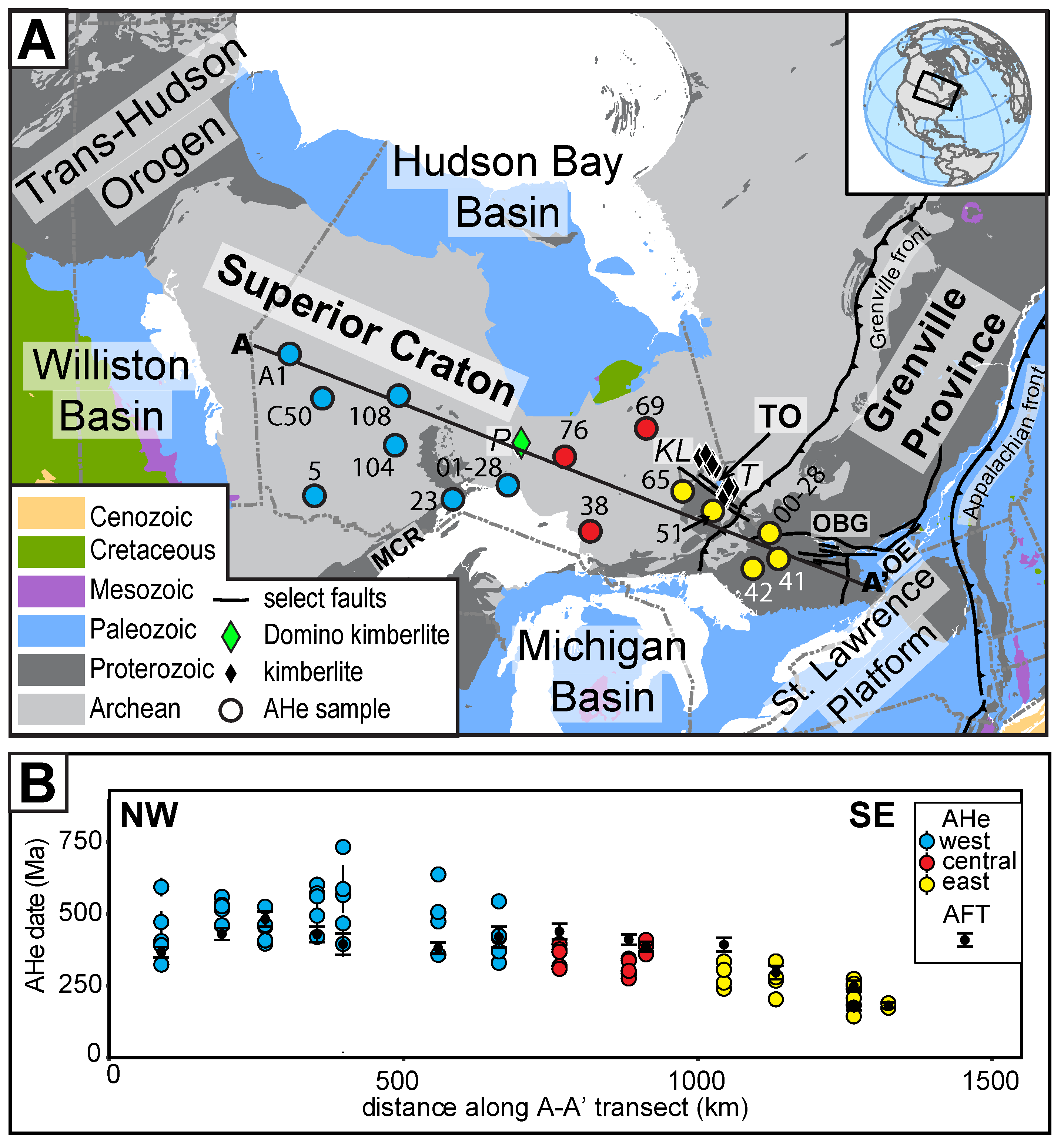
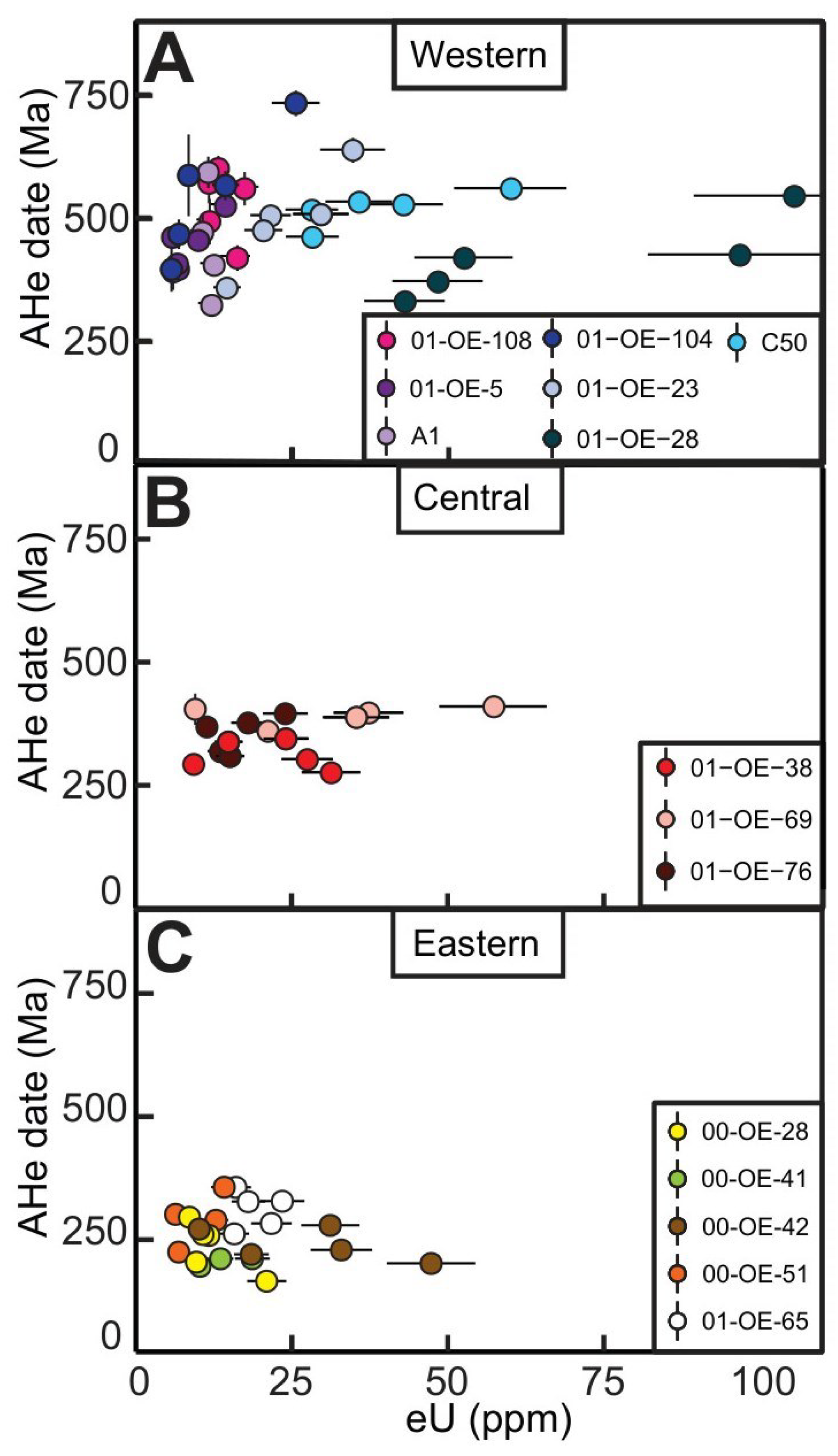
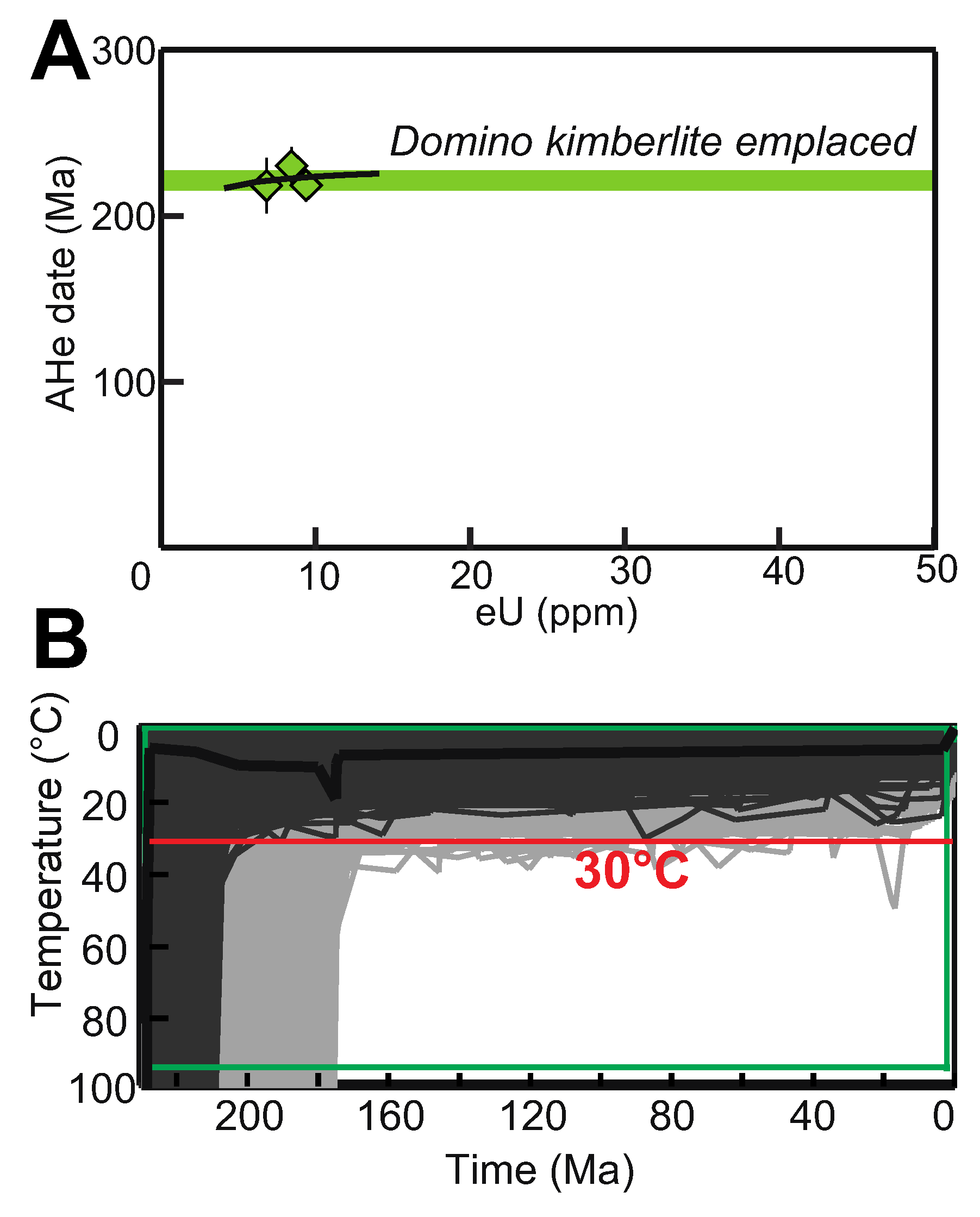
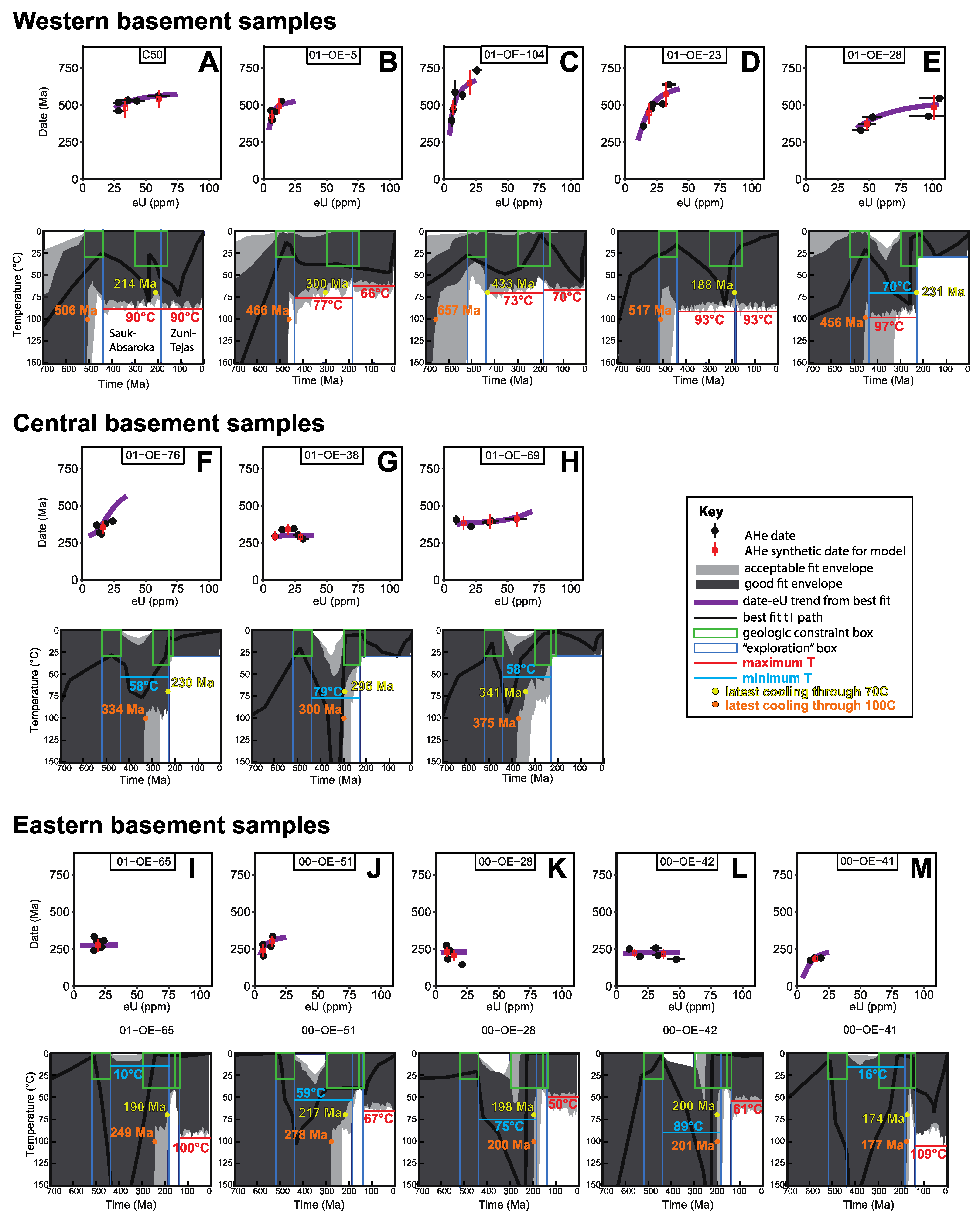
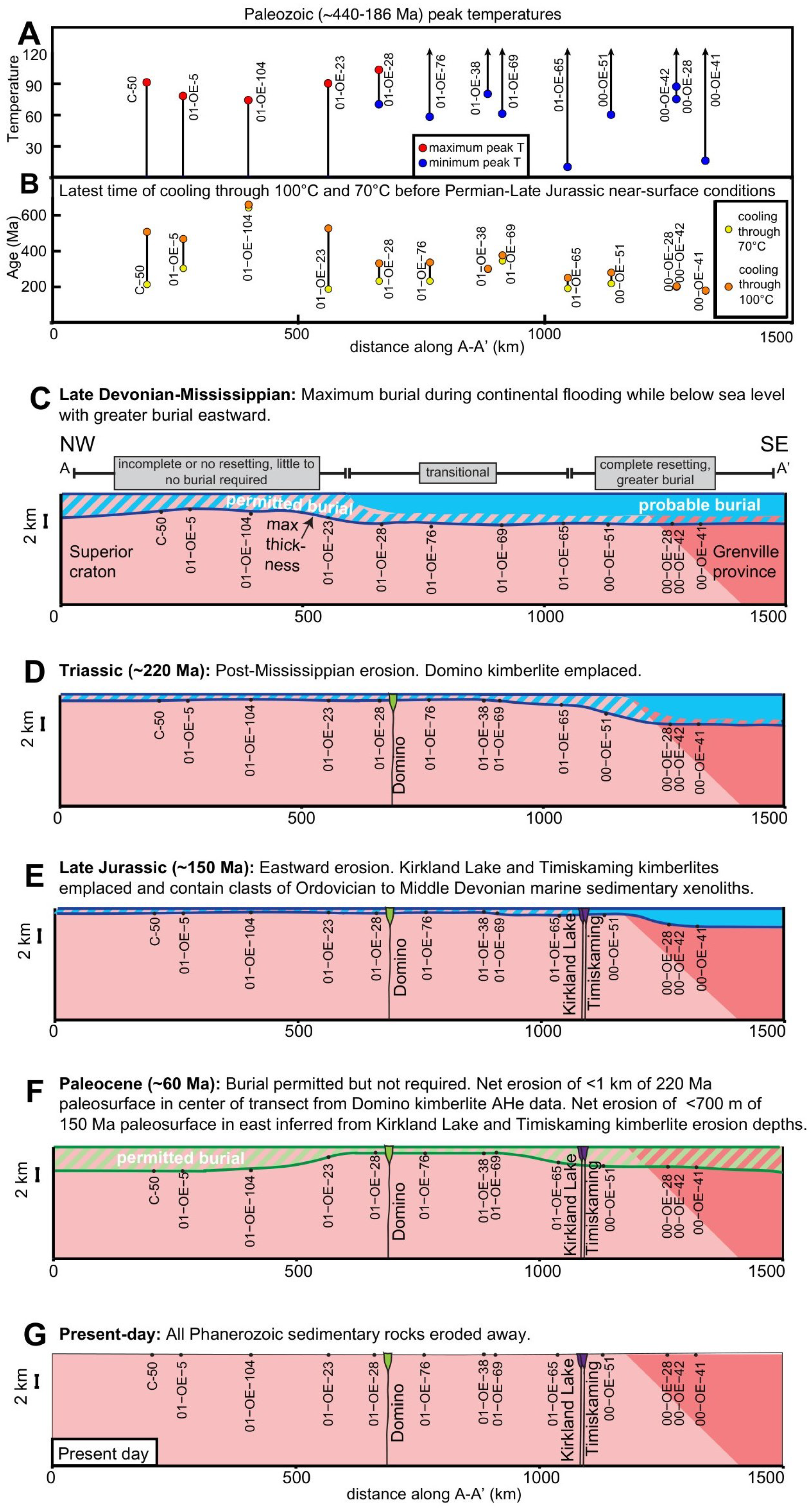
Disclaimer/Publisher’s Note: The statements, opinions and data contained in all publications are solely those of the individual author(s) and contributor(s) and not of MDPI and/or the editor(s). MDPI and/or the editor(s) disclaim responsibility for any injury to people or property resulting from any ideas, methods, instructions or products referred to in the content. |
© 2024 by the authors. Licensee MDPI, Basel, Switzerland. This article is an open access article distributed under the terms and conditions of the Creative Commons Attribution (CC BY) license (https://creativecommons.org/licenses/by/4.0/).
Share and Cite
Sturrock, C.P.; Flowers, R.M.; Kohn, B.P.; Metcalf, J.R. Phanerozoic Burial and Erosion History of the Southern Canadian Shield from Apatite (U-Th)/He Thermochronology. Minerals 2024, 14, 57. https://doi.org/10.3390/min14010057
Sturrock CP, Flowers RM, Kohn BP, Metcalf JR. Phanerozoic Burial and Erosion History of the Southern Canadian Shield from Apatite (U-Th)/He Thermochronology. Minerals. 2024; 14(1):57. https://doi.org/10.3390/min14010057
Chicago/Turabian StyleSturrock, Colin P., Rebecca M. Flowers, Barry P. Kohn, and James R. Metcalf. 2024. "Phanerozoic Burial and Erosion History of the Southern Canadian Shield from Apatite (U-Th)/He Thermochronology" Minerals 14, no. 1: 57. https://doi.org/10.3390/min14010057
APA StyleSturrock, C. P., Flowers, R. M., Kohn, B. P., & Metcalf, J. R. (2024). Phanerozoic Burial and Erosion History of the Southern Canadian Shield from Apatite (U-Th)/He Thermochronology. Minerals, 14(1), 57. https://doi.org/10.3390/min14010057





